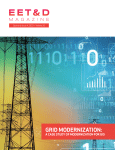From his first days in office, President Joe Biden has targeted climate change as a top priority. The administration’s key achievement on this front has been pushing through the Inflation Reduction Act, the largest climate action ever taken in history.
Among a raft of innovations, programs and incentives in the act, the administration also set ambitious climate goals, including a pollution-free power sector by 2035 and a net-zero economy by 2050. While much of the focus has been on infrastructure deployment, look for much of the work to be implemented by an unlikely suspect: A new generation of AI-enabled software.
Utilities, as large power producers, are a prime target for decarbonization. Following pressure from regulators, customers, investors and other stakeholders, all major American electric utilities have set net-zero goals, although this has already proven to be a challenge for most. Utilities are massively complex organizations with conservative histories. Their incentives have always been to keep the lights on affordably and safely and deliver modest but steady shareholder returns—not to slash emissions. So, innovation has often taken a backseat to reliability.
Yet meeting these decarbonization deadlines will require widespread changes, and utilities must act quickly or risk falling behind. That will require unprecedented investments and support: The International Energy Agency estimates governments and the private sector will need to invest $4 trillion annually by the end of this decade to reach net-zero emissions by 2050. That’s a fourfold spending increase from 2022 levels.
As part of the industry’s most active venture capital investor, I have a first-hand view of the work utilities are undertaking to reach net zero. Achieving these ambitious goals will take more than building infrastructure like solar, wind, storage and transmission. While those investments are critical, software must also be an essential part of the decarbonization mix to optimize assets, boost efficiency and operationalize sustainability, all with an eye toward achieving the lowest possible overall operating costs.
We call this type of investing operational efficiency. We’re keenly aware that reaching net zero has to be done in a way that is affordable for our customers. The goal is to be able to reach decarbonization objectives while keeping our customer rate increases to the minimum amount possible. Improving the efficiency of our infrastructure and operations via new and advanced software is therefore key to our cost objectives. Operational efficiency is an under-hyped but vital component of net-zero efforts: If nobody can afford clean energy, net zero could face a backlash as we’ve seen for many ESG initiatives.
Software will be a critical part of our net-zero journey. Here’s how we can give it the attention it deserves.
Prioritize business efficiency
This one’s fundamental: We’ll only reach net-zero goals if energy companies adopt business efficiency software.
Although it will never generate as many headlines as big infrastructure projects, using software to keep utilities running faster, more efficiently and with less bloat is immensely valuable — and deeply needed for many legacy operators. Utilities would do well to reassess their project management tools, budgeting platforms, customer service desks, billing solutions, HR management — every aspect of their back-office stack. Existing cloud software offerings can offer massive efficiencies many other businesses take for granted and can make a material impact on getting things done faster.
Embrace artificial intelligence and machine learning
In addition to existing cloud applications, operational efficiencies are suddenly being driven faster than ever by the rise of artificial intelligence. AI technology promises tremendous efficiencies as well as new products and services that can help solve some of our biggest problems — including climate change. Complex datasets like electric grids are perfectly suited to benefit from an AI layer.
AI is already helping utilities and their customers manage solar, wind, batteries and EVs across the grid while optimizing transmission lines to carry more renewable power. AI can match power generation to demand, putting the “smart” into smart grid. Utilities are also using AI to boost worker safety, enable predictive maintenance, monitor critical infrastructure and ensure quality data from sensors and other assets. And AI is reducing carbon emissions by facilitating demand-response programs that encourage customers to use less energy during peak demand.
Here’s one small example that can illuminate the massive opportunity. AI can pinpoint problematic areas within the grid where vegetation management crews should prioritize the battle against overgrowth. One company in the vegetation management space, for instance, uses satellite data and artificial intelligence to help utilities spot trees that could fall and damage power lines. That’s helped improve grid reliability by 10% — a vital metric for utilities. It has also materially reduced our operating expense budget for vegetation management by changing the maintenance model from time-based to condition-based. This targets maintenance activities to the areas that need work versus those that don’t.
Adopt visualization tools
Better visualization is another way software will have an outsized impact on net-zero goals. New software tools can help utilities create “digital twins” — virtual copies of the real-world environments where they’re planning, building or maintaining clean-energy assets. By working with a comprehensive digital visualization, utilities can plan faster while identifying potential construction problems before they happen — and reduce the need to deploy costly worker teams.
One of the fast-growing players is a visualization software company based in the UK, whose platform improves coordination and communication by helping teams understand extremely complex, large-scale projects. This UK-based visualization software company is already working with several utilities and energy companies, including United Utilities and Lightrock Power. In 2021, the visualization software company also helped United Utilities reach its 2025 goal of reducing water leakage by 15% The startup is meshing thermal data captured by drones with high-resolution photogrammetry that creates a predic-tive algorithm identifying locations where leaks are most likely to spring.
As better visualization software arrives tailored to the needs of the energy sector, legacy utilities will spot countless areas where the software can boost efficiency, reduce costs, improve safety and speed the deployment of clean energy.
Improve cybersecurity
As utilities update the grid to make it smarter, it will become increasingly connected. That provides tremendous opportunity for efficiencies and more clean energy assets, but it also provides more opportunities for attacks that can take networks offline, impede operations and interrupt service to customers.
Physical attacks on power grids rose by 77% last year in the U.S. alone, according to the Department of Energy. And the potential scope of cyber attacks is even greater. America’s power system connects 145 million customers and nearly every person and business; should an attack hit multiple targets across the country, the effect could be catastrophic.
Utilities must adopt real-time asset identification, constant threat detection and immediate response software to keep the power on. Making cybersecurity a priority will not only require an innovation effort but also a cultural shift. Security leaders will need to make sure they’re providing proper onboarding and consistent training to employees.
A leader in the real-time asset identification space is a Virginia-based company that was founded by a team from the National Security Agency and provides comprehensive management and response capabilities for industrial control systems; it already has hundreds of industrial customers, including 10 of the largest U.S. electric utilities, water utilities and energy providers. The company tracks dozens of different industrial hacker groups, including numerous national state bad actors, that specifically target the electric utility industry.
Cyber attacks will only become more sophisticated as hackers themselves increasingly turn to tools like AI. Utilities will need to continue rapidly evolving and adopting the latest software to stay ahead and protect our nation’s energy grid.
Overcoming the red tape and placing customers first
But none of these software innovations will reach their full potential to transform energy infrastructure and combat climate change if utilities aren't better incentivized to pursue them.
Most other companies reach for software before hardware or infrastructure when possible for a simple reason: Software is usually far less expensive. But in the utility world, there’s a regulatory twist: The government guarantees utilities can bank a predictable rate of return on all capital expenditures. In other words, if a utility builds an expensive, capital-intensive power plant, a portion of those costs usually can be passed along to customers under current regulations. But operating expenditures — under which software investments typically fall — can’t be passed along so easily because they’re categorized as a cost of doing business.
As a result, utilities are incentivized to think construction-first, not software first. The downside is that capital expenditures almost always cost more than software implementations — especially software-as-a-service, which can be paid over time. Capital projects also take much longer to implement, which translates to slower progress on net-zero goals, more environmental damage and, in many cases, more costs passed on to end customers.
Utilities and regulators must work together to change the incentives and accelerate software adoption. It’s an obvious win-win for the public, as well as for utilities and their stakeholders.
Software will show us the way
Utilities face incredible challenges ahead. They must scale clean energy production, transmission and distribution to support the electrification of everything, all while maintaining reliability, minimizing price hikes and adopting intermittent clean energy resources like wind and solar.
That’s why building a net-zero utility must be focused every bit as much on software as large-scale infrastructure. It’s simply the best way to reduce emissions at the lowest cost — and software continues to improve at breakneck speed.
From AI, visualization and cybersecurity to business management, utility software deployments are just getting started. They can help make the most of existing and new infrastructure and are poised to kick off a golden era for utility innovation. Best of all, the software keeps getting smart — and I for one can’t wait to see what comes next.
 Andre Turenne is vice president of Pathfinding and Incubation Investments at National Grid Partners, where he is instrumental in delivering both strategic and financial returns. He has more than 30 years of venture capital, business development, operating and technical experience spanning a wide range of areas, including enterprise software & services, SaaS/cloud, Data Analytics/AI, IT & network infrastructure, IoT/connected, digital utility/smart grid wireless and security.
Andre Turenne is vice president of Pathfinding and Incubation Investments at National Grid Partners, where he is instrumental in delivering both strategic and financial returns. He has more than 30 years of venture capital, business development, operating and technical experience spanning a wide range of areas, including enterprise software & services, SaaS/cloud, Data Analytics/AI, IT & network infrastructure, IoT/connected, digital utility/smart grid wireless and security.







